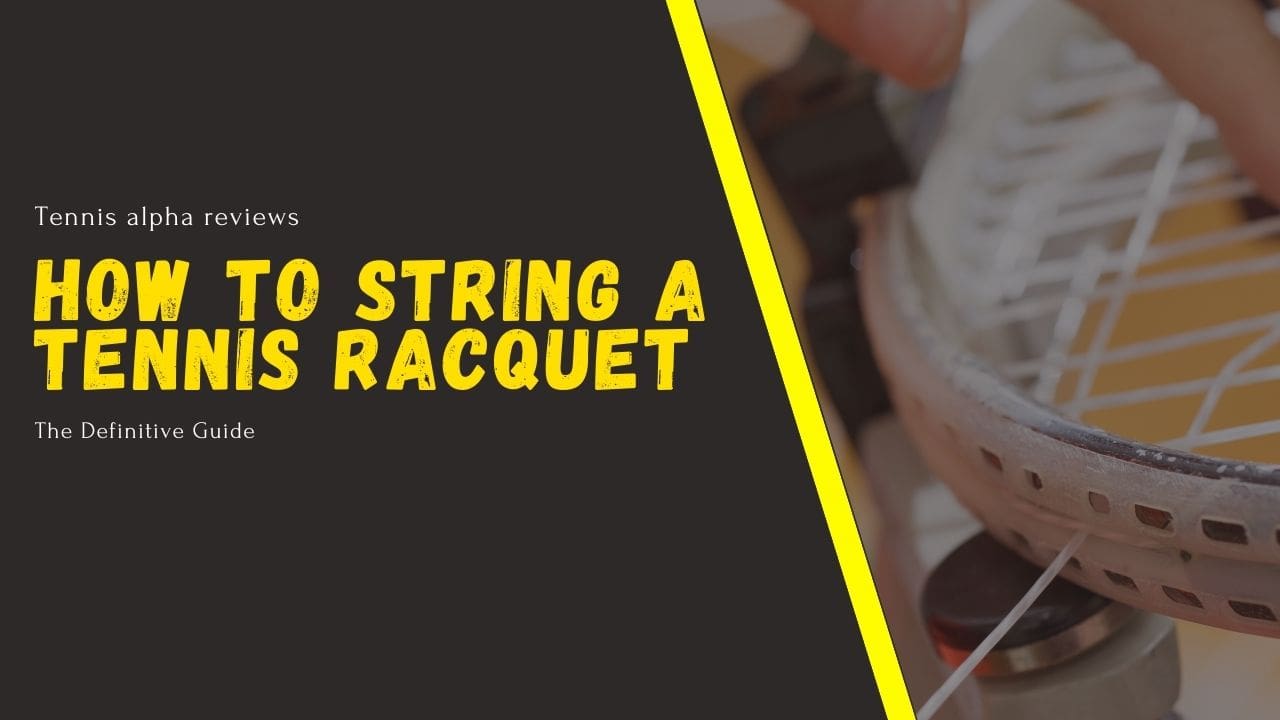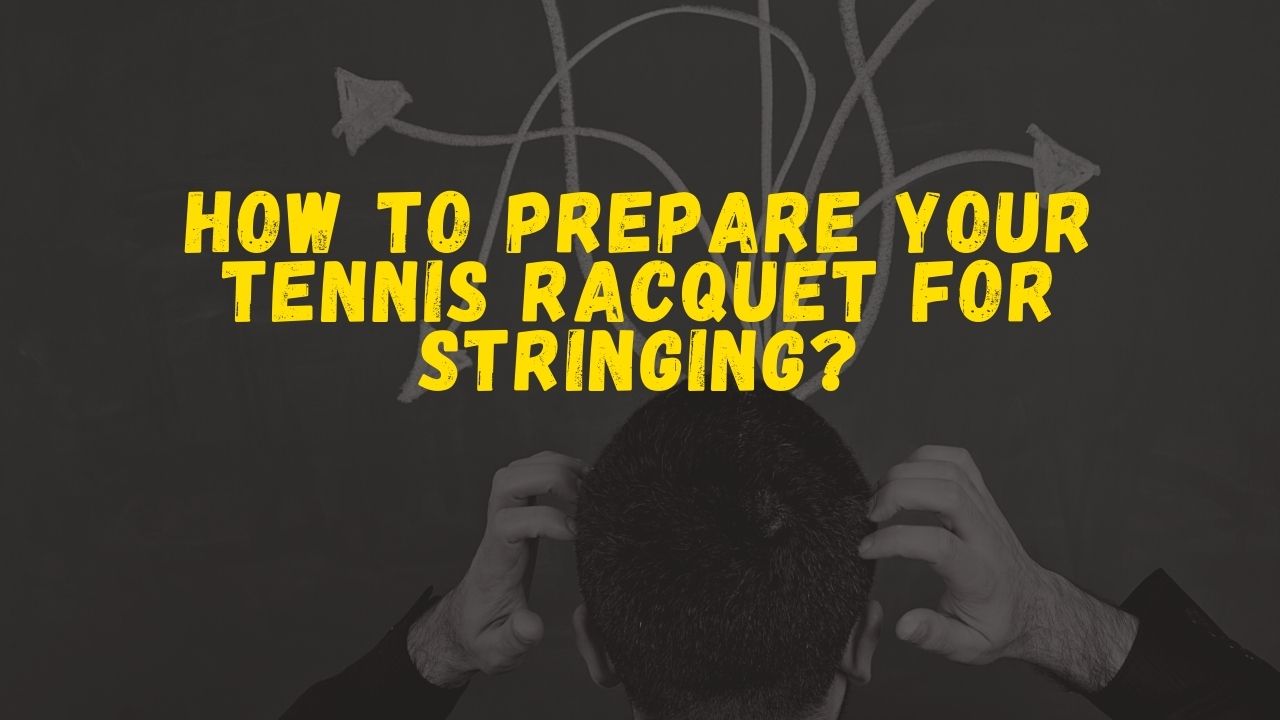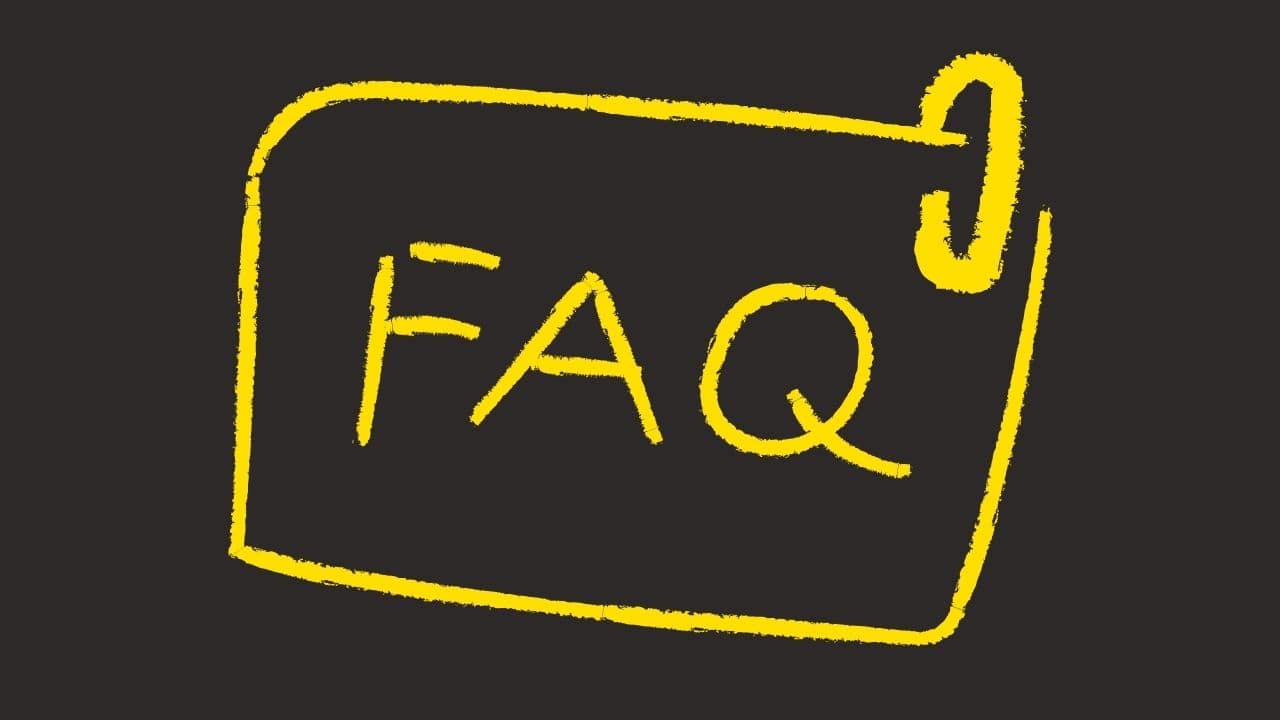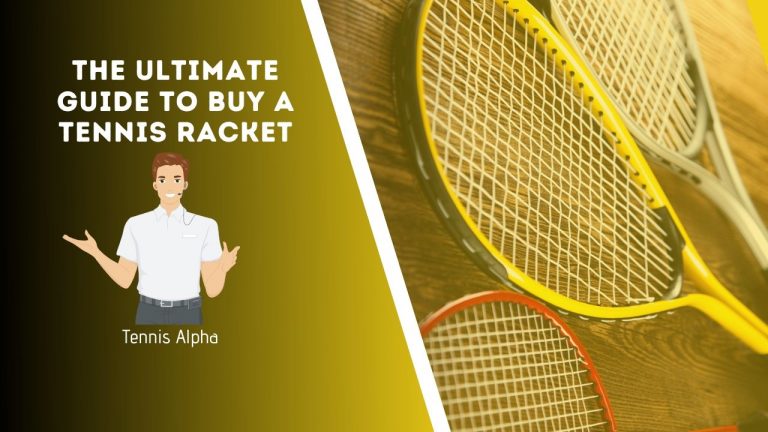
Stringing a tennis racquet can be confusing for a lot of tennis players, it’s a step by step process that needs to be done correctly so today we decided to write this article to answer all of your questions on how to string a tennis racquet as well as choosing the right strings for your tennis racquet.
How to choose the right strings for your tennis racquet?

Choosing the right string for tennis is not trivial. A bad choice and we can find ourselves playing with equipment that does not suit us, that does not correspond to the characteristics of our game, or even that tires our arm and joints. So, here are some tips to help you choose your stringing, depending on your racquet and… on yourself.
There are many different tennis racquet strings options, so it can be difficult to know which one to choose.
As with racquets, a good solution is to test a few to see which type is best for you.
However, depending on the type of game and the sensations you are looking for, you can determine which type of strings to choose.
Your strings must be adapted to the racquet
In a few words, if you own a light racquet, below 300 grams, it generates more shocks (18% exactly) on the forearm than a racquet weighing more than 300g. And therefore more muscle fatigue. Therefore, we can say that a light racquet offers lightness and maneuverability, while a heavier racquet guarantees more power. We can then privilege :
- A polyurethane multifilament strings for a racquet under 300g, which, being more elastic, will generate maximum power for less arm fatigue.
- A polyester monofilament string for a racquet weighing more than 300g, a stiffer string that offers better control but also generates more arm fatigue.
The stringing must consider your game and the type of player you are
One of the important things to remember when choosing strings is that you need to consider your play and physical abilities.
There is no point in copying the stringing (or even the racquet!) of your favorite player under the pretext that he plays well with this material.
And since the ball that arrives at the center of the racquet causes very important vibrations (100G shock for a ball thrown at 70km/h), the choice is decisive.
When we talk about the type of player, this refers to gender, age, but above all to the frequency of practice and physical abilities (morphology, possible injuries…). Also, it refers to the style of play (based on big hits, very good defense and movement, big serve, etc.).
- If you are looking for power. You’d like sharper, more aggressive shots with a lower stroke length. Then you can go for a multi-filament string system like the HDX Tour, Duramix, or TGV for added comfort. Alternatively, you can also lower the tension of the strings, which increases the trampoline effect and therefore the power or lower the gauge of the strings (which decreases its resistance).
- If you are looking for control. You want to make fewer mistakes or a lot of power through equipment that gives you security and control. Conversely, you can increase the gauge or the tension of your strings here. Alternatively, opt for a softer polyester string, such as Black Code or Razor Code.
Be careful however, this type of string is more demanding on the forearm, be sure to be morphologically at the point before choosing a rigid string. Similarly, this type of string is not recommended for young, growing players: it could increase the chances of injury as they grow older.
- If you are looking for comfort. To avoid injuries, it’s better to opt for a multifilament string such as the XOne Biphase, which is softer, more powerful, and therefore more comfortable. The vibrations are less felt, but you lose control.
Don’t buy the first strings you come across, but take into account the different types of strings
The polyester monofilament, the choice of control to avoid in case of pain and lack of power
Monofilament strings are made of polyester only. They are strings that provide resistance and control, to the detriment of comfort (muscle fatigue of the forearm). Polyester should therefore be avoided in case of arm pain, as well as for young players who train very often and risk injury.
2 facts to remember: if the polyester monofilament is 38% stiffer than the polyurethane multifilament, it also generates 22% more muscle fatigue when hitting!
Hybrid string: it is possible to combine the strength and control of polyester (mainly on riser strings), with the power and flexibility of nylon or multifilament, in order to gain comfort and ball length.
The multifilament strings: comfort & power
Multifilament strings are made of multiple intertwined filaments. The polyester discussed above can therefore be added to polyamide, for example, to give softer strings, such as Duramix.
Multifilaments are more elastic and comfortable, but they are also less resistant. In terms of game characteristics, they provide more power (they are similar to natural gut, which is more expensive) and more comfort, limiting the pain associated with repeated impacts with the ball.
Hybrid strings: just as nylon can be combined with polyester, the multifilament, which is similar to nylon, can be combined with polyester. In this case, it is often preferable to position the multifilament horizontally and the polyester vertically. Indeed, the rising strings move more on impact with the ball, are progressively cut by the cross strings, and this is why one may want vertical resistant strings.
Conclusion
When choosing your strings, take into account your type of play, your body type, and your racquet, but most importantly, try different types of strings before you choose, to see how they react to your play and to hit.
Best Tennis Strings of 2021: The Definitive Guide
How to Prepare your tennis racquet for stringing

The frame
It is necessary to examine hole by hole the state of the racquet’s rushes (head and core), wear appears especially at the exit of the eyelets, inner side.
Apart from the difficulty to get the right model of the head rings, it is difficult to perfectly reattach a head ring on a frame. If two or three eyelets need to be repaired, it is best to keep the original rod and simply run a plastic sleeve through the damaged eyelets, making sure to leave just the right amount of excess length.
It is also obvious that any canopy, cracks, or abnormal wear of the frame must be detected in order to estimate the impact on its lifespan.
The string
The string should be unrolled carefully avoiding tangles. To do this, hold the wrapping in one hand, and with the other hand, unwind the strings one turn at a time, starting from one end. Then smooth it between your fingers along its entire length to eliminate twists.
If a spool of strings is used (200 m being the most common), an accurate measurement of the length of string to be cut must be taken. If in doubt, cut to 12 m, which is the standard length of strings sold by the unit.
In order to avoid frame deformation, be sure to cut your string crosswise as soon as possible as soon as a string breaks, in order to rebalance the tensions on the frame.
What is the best Stringing Process?

Main Strings
To determine where to start, count the number of holes in the heart (inside the Y):
- If you count 4, 8, or 12 holes, start at the head of the racquet, starting from the center.
- If you count 2, 6, or 10 holes, start at the heart, starting from the center.
The best method is to string the strings alternately, which requires a machine with two clamps. One or two strings are stretched on one side of the frame, then one or two strings are stretched on the other side, and so on for all the studs.
This compensates for the pressure on the frame (the frame is subjected to a pressure of about 150 kg once the racquet is strung).
As far as skipping holes is concerned, holes are usually skipped for the last two strings on each side (see stringing plan of the racquet manufacturer or second strung racquet available).
Cross Strings
Pay attention to the interlacing of the strings when passing above and below the studs. It’s easy to skip a post (or to make a mistake between the top and bottom of the first post when starting the pass), which results in shifting the remaining strings and ruining the rest of your work.
In order to avoid realizing too late that you are making these switching errors, get into the habit, at a glance, of checking, for each crossbar, the entry on the first post and the exit on the last post, which must necessarily be reversed.
Also, make sure to start the next crossover in the opposite direction to the arrival of the previous crossover, unless the pass starts from a different amount.
Passing through holes already occupied by an upright is a delicate operation. The string must be cut at an angle and then carefully inserted into the eyelet. If necessary, use flat pliers to push it in millimeters by millimeters. It is also possible to try to enlarge the passage by using a punch, but be careful not to “hurt” the upright in place.
As for the alternate “top-to-bottom” passage, there are many methods. The basic technique consists of placing one hand above and one below the uprights. The fingers on top are used to push the string down once it has been passed over the upright; the fingers below are used to pull the string up once it has been passed under the upright. These hands move in a crosswise direction and carry the string with them.
When interlacing, do not try to work perpendicular to the uprights, but diagonally, which makes it easier to slide across. Then, to make the crosspiece take its approximate place, place your punch in the middle of the uprights so that the crosspiece forms a “V” by pulling on it by hand, which avoids too much friction and localized wear of the uprights.
In order to limit friction when passing through the crossbeams, it is advisable to pass two cross beams at the start and then always have one crossbeam ahead of the last crossbeam under tension.
The two stringing methods
The installation principles described above apply to both methods:
- Single-ended method: only one length of the string is used for the uprights and crosspieces (two stop knots are visible on the screen).
- 2-end method: two lengths of strings are used (possible hybrid strings and/or different tensions), one for the uprights, the other for the cross members (four knots are visible on the screen).
With a string length of 12 m (the usual length of strings sold individually), you are sure to cover all screen sizes (6.5 m for the uprights and 5.5 m for the crosspieces).
The “ad-hoc” length is generally much less than 12 m; it varies according to the size of the racquet and the number of uprights and crosspieces. Its knowledge allows to cut it as precisely as possible if a spool is used (with 200 m, one string on average 18 to 19 adult snowshoes).
The realization of the stop knots always remains a source of tension loss. It is recommended to increase the tension of the last string by 2 kg to compensate for this loss.
What String tension to choose?

In tennis, the tension of the string of your racquet can have a significant impact on your game. To optimize your performance, you need to ensure a balance between tension, materials, type of game, and string gauge. Discover all our tips for adapting the tension of your string pattern to your game.
What is the string tension of a tennis racquet?
String tension is used to determine the weight required to tension the string on either side of the racquet frame. The string tension is usually between 20 and 30 kilograms. Some players use extreme string tensions from 9kg to 42kg to surprise their opponents with ball spin.
The string gauge indicates the diameter of the string used. This value is expressed in millimeters or in numbers from 15 to 18 for US values.
You will probably hear about the trampoline effect. This is the vibration caused by the power of the ball on landing. A loose rope will absorb the energy after the ball has sunk into the sieve.
These two parameters affect your string’s performance.
A string tension lower than 20 kg brings power, comfort, and effect. On the other hand, a low tension induces a more difficult control and less precision.
String tension over 25 kg gives you more control and precision in your strikes but increases the risk of tennis elbow injury. This is because the ball speed is not dampened by the stringing, it transmits many vibrations to the rest of the racquet and therefore to your arm. In addition, you lose striking power and ball effect.
How to Choose String Tension?
the choice of string tension will impact the control, power, spin, and feel of your tennis racquet. This factor will depend on several parameters including the type of string used. It is considered that multi-filament, gut, and hybrid strings should have a tension of around 21 to 25 kilograms. On the other hand, the optimal tension of a monofilament rope is between 19 and 25 kg.
Polyester and Kevlar strings are stiffer, so it is best to reduce their tension by one or two kilos to compensate.
In general, the first step is to reduce the tension of the horizontal strings. They are shorter so the impact is less important if you want to adjust your tension little by little. In order to know the exact tension, be aware that there are small electronic and dynamic measuring devices available.
What tension for a gut string?
The gut strings stretched between 21 and 25 kg can offer you more power and comfort than other materials. On the other hand, it will affect the effectiveness and the life of your string.
What tension for multifilament strings?
The multifilament strings will give you better performance with a tension between 21 and 25 kg. With a homogeneity of performance in terms of power, comfort, without reducing the effect or altering your string.
What tension for hybrid strings?
Hybrid strings tensioned between 21 and 25 kg gives you a performance that is inversely proportional to that of a multifilament string under the same tension. A balanced ratio between effect and power.
What tension for monofilament strings?
The ideal tension for monofilament strings is between 19 and 25 kg. In this case, the resistance and the effect will be largely privileged in spite of the power and comfort.
FaQs

What is the right string length for a tennis racquet?
The length required for a string depends on the size of the string screen and the stringing plan of the racquet. For an average tennis racquet, a good stringer will use about 11m of strings. That is 9 to 10 strings for a 110m reel.
How to string a tennis racquet with 4 knots?
So I recommend the 4-knot stringing. All the advantages are there: You start by stringing your uprights at 22 kg for example. You reach the last post on the left, you stretch it 4 kg above (26kg), and you make your knot. The 4 kg will disappear because your knot will loosen the string.
When to change tennis racquet strings?
Tennis racquet strings can be changed at least once a year if you use your racquet very little, even if the string is not broken, and as many times as you play per week if you play regularly (if you play 3 times a week, change the string at least 3 times a year, etc.).
How to know the string tension of your racquet?
String tension is the weight that will be applied to each string of the racquet to tighten it. It is usually between 20 and 30 kg and its value will depend on several factors including your level, playing style, the racquet, and the string you are using.
Summary
So guys Here is the complete guide on how to string a tennis racquet, I have shared with you all you need to know to understand the stringing process.
Which part of this article do you like most? Let me know in the comment section!
Now it’s your turn to enjoy this amazing sport.
If you liked this article make sure to share it with your friends.



